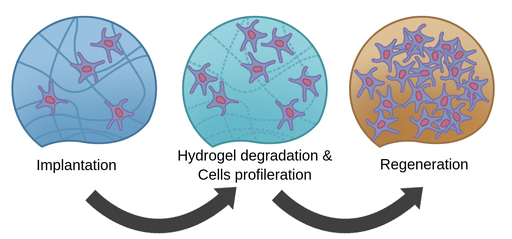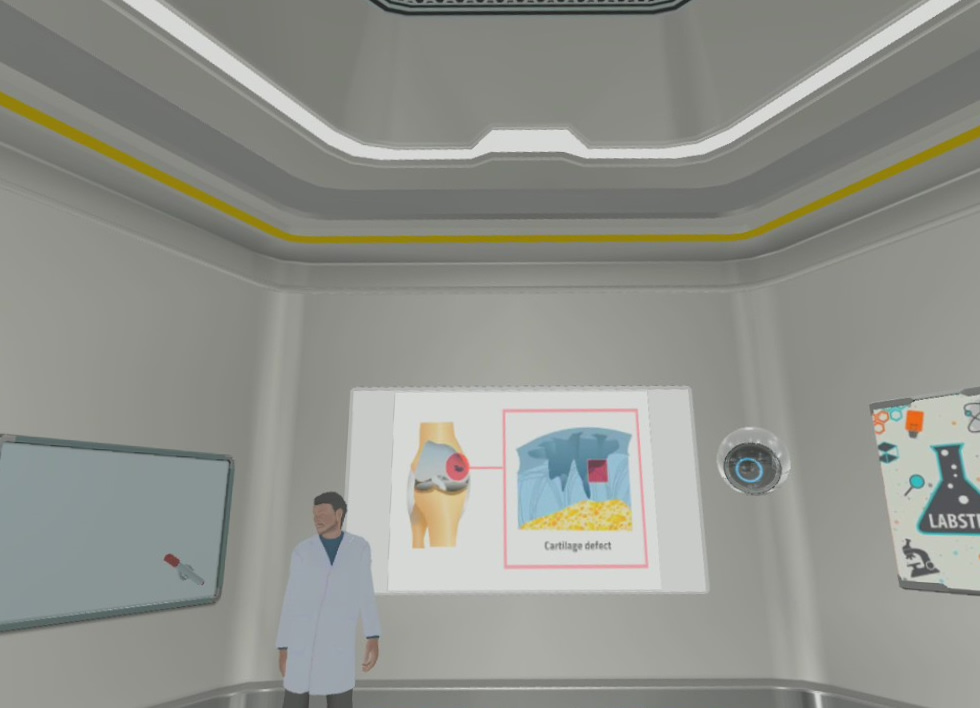
Tissue engineering is a field of regenerative medicine that is concerned with the development of substitutes for damaged tissues. In tissue engineering, many methods are used to repair or replace damaged tissue with synthetics or natural mimics. The principles of life sciences and engineering are combined to develop substitutes for tissues. Tissue engineering involves different areas including molecular biology, chemistry, medicine, and cell biology.
Tissue is made up of cells that have the same structures and functions together. There are four main types of tissues; muscle tissue, connective tissue, epithelial tissue, and nervous tissue. The importance of tissues is that they represent the differentiation of cells in organisms.
The main aim of tissue engineering is to use the body’s own capacity to repair the tissue with scaffold, growth factors, and endogenous cells. The tissues of the skin, heart, cartilage, pancreas, and heart can be repaired by tissue engineering. The practitioners can repair, maintain, and replace certain organs and tissues in humans. With the help of tissue engineering, we can translate information about developmental biology in the hospitals.
Articular cartilage has gained popularity in the field of tissue engineering. Articular cartilage is a smooth connective tissue that covers the ends of the bone. With healthy joints, you can move your joints easily. If it is damaged by the injury then you have to experience serious consequences. Cartilage is formed by long chain polymers that can swell in an aqueous medium. These cartilages do not contain blood vessels, nerves, and lymphatic nodes.
There are several aspects of tissue engineering that may be confusing for students. At Labster’s, we can provide you with information about the reasons that make tissue engineering a difficult topic and five ways that make this topic easier to understand. In the end, we will convince you why a virtual lab simulation is important for students as well as for teachers to deliver the topics effectively.

Figure: An image showing the process of tissue engineering in the damaged cartilage from Labster’s theory page.
Tissue engineering is a vast topic, some students do not like it due to the complexities and complications of the topic. There are three main reasons that make tissue engineering topic difficult to learn.
Sometimes, it is difficult for students to learn abstract concepts. In tissue engineering, students learn about tissues, cells, extracellular matrix (ECM), and scaffolds which can be difficult for students to imagine. If we talk about cells, tissues, and organelles, these cannot be seen through the naked eye. You need to use a microscope to see these things. Students may find it hard to remember abstract concepts due to difficulty to imagine the structures.
Tissue engineering is the combination of different other fields including engineering, molecular biology, cell biology, and chemistry. Also, it is necessary to learn about tissues, cells, and processes of tissue engineering that make this topic hard to remember. Students may find tissue engineering a complicated topic.
In tissue engineering, students need to learn detail about the cells, tissues, cartilage, and their functions and structures. Polymers have different types that are used in tissue engineering. Tissue engineering is a detailed topic, so students may find it boring and time-consuming.
Since we know the main reasons that make tissue engineering difficult to understand. Here are five ways that can help the students as well as teachers to understand tissue engineering.
Eugene Bell (1919 – 2007)
Eugene Bell was an MIT biology professor who worked in the field of regenerative medicine. He developed a new technique to grow skin tissues for burn victims in 1980. He had done great research and introduced the world to advanced tissue engineering. Eugene Bell is known as the “Father of tissue engineering”. He published a study that tells information about the repairing of wounds with artificial skin tissue. Artificial skin tissue can be made of human or animal cells. Several synthetic skin graft companies use Bell’s concept to make substitute skin.
Dr. Joseph Vacanti and Dr. Robert Langer
In the mid-1980s, Dr. Joseph Vacanti approached Dr. Robert Langer and introduced the idea of scaffoldings. Dr. Vacanti worked on scaffolding and discovered that the chemical and physical properties of naturally occurring scaffoldings cannot be manipulated easily. So, he designed synthetic scaffoldings that could be biodegradable and biocompatible polymers. The introduction of scaffolding is the result of the great work of Dr. Vacanti and Dr. Langer.
The three main components used in tissue engineering are cells, scaffolds, and bioactive molecules. The cells provide an extracellular matrix that is helpful in the regrowth of tissues. Scaffolds can provide temporary support during tissue formation. Scaffolds are injected directly into the injured site that can regenerate the tissue in the patient’s own body. The other way of implantation is to culture the tissue to become mature in vitro. Bioactive molecules can help to provide support in the formation of tissues. Examples of bioactive molecules are growth factors and cytokines.
As scaffolds play an important role in tissue engineering. Students should know the types of scaffolds. It has three types that are following:
Porous scaffolds: The porous scaffolds provide a larger surface area and are used for bone tissue. They can be produced by several processes including freeze drying, phase separation, and particulate leaching.
Fibrous scaffolds: Fibrous scaffolds can easily create substitutes for extracellular matrix (ECM). Cells are affected by the size and structure of the fibers.
Hydrogel: Hydrogels are polymers that swell in water. Hydrogels can be present naturally and also produced synthetically. Examples of natural hydrogels are agarose, hyaluronan, Matrigel, and methylcellulose.
The main purpose of the development of scaffolds is to induce less swelling, increase the removal of waste products, and allow the gas and nutrients to the cell. An effective scaffold can be biodegradable and biocompatible, so it can produce better substitute tissues.

Figure: An image of hydrogel implantation and regeneration of cells from Labster’s theory.
When students learn about real-world examples of tissue engineering, it enhances their interest in this topic. Teachers can give examples of tissue engineering that is done in the laboratories. Generally, tissue engineering is used to regrow and repair damaged tissues and whole organs. There are several examples of tissue engineering in the real world. Knowing about these examples of tissue engineering can increase the information of students.
Use in skin graft surgeries: Tissue engineering for bones can be helpful in skin graft surgeries. So, it is an effective way to treat complex wounds including burns.
Recreation of the kidney: The substitute tissues of the urinary bladder and urethra are also developed by tissue engineering. Therefore, it is effective for the treatment of renal diseases.
Implantation of human liver in mice: The human liver can implant in mice with the help of tissue engineering to drug interaction. It is used to check the toxicity and specific response of drugs. The human liver implanted in the mic can metabolize drugs in the same manner as humans do.
Tissue engineering of complex tissues: Complex tissues such as heart tissues, lungs tissues, and liver tissues are recreated in the laboratory.
Color diagrams can play an effective role to understand tissue engineering. Virtual images can make a tough topic like tissue engineering simpler to learn. Through virtual diagrams, students understand the structure of tissue, articular cartilage, polymers, and scaffold. Moreover, it is a better way to deliver the concepts of tissue engineering.
As tissue engineering comprises different methods to repair damaged tissue, color animations can help learners to understand it effectively. The color image below represents the cartilage defect. With the help of this image, the students will know the structure and position of cartilage. It helps to enhance their imagination towards the complex topic of tissue engineering.

Figure: An image of a cartilage defect is taken from Labster’s virtual laboratory on tissue engineering.
Learning through virtual labs is an advanced way to get knowledge about difficult topics like tissue engineering. At Labster, we can provide an advanced laboratory simulation with gamification and storytelling elements. When students learn from virtual lab simulations, they can see the 3D structures of tissues, organs, and cells.
So, check out Labster’s virtual lab simulation related to tissue engineering. This simulation explains the principle of tissue engineering, types of crosslinking, natural and synthetic polymers, and mechanical properties of hydrogels by using rheology. Teachers can use the virtual lab to explain the topic to the students appropriately.

Get in touch to find out how you can start a virtual lab simulation to explain tissue engineering to your students.

Labster helps universities and high schools enhance student success in STEM.
Request DemoRequest a demo to discover how Labster helps high schools and universities enhance student success.
Request Demo